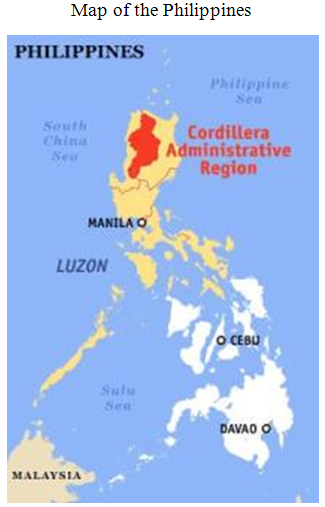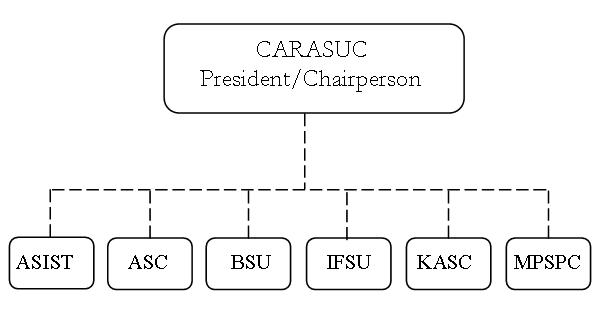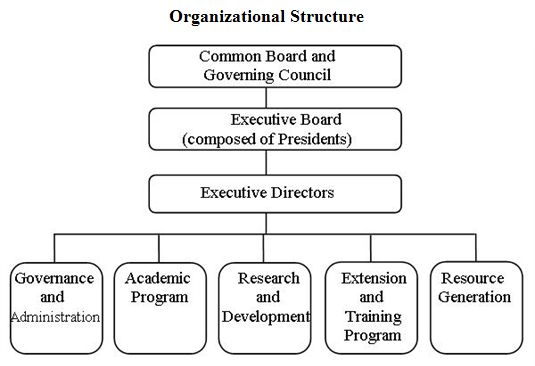-
Paper Information
- Paper Submission
-
Journal Information
- About This Journal
- Editorial Board
- Current Issue
- Archive
- Author Guidelines
- Contact Us
Education
p-ISSN: 2162-9463 e-ISSN: 2162-8467
2015; 5(1): 15-19
doi:10.5923/j.edu.20150501.03
Amalgamation in Philippine Higher Education: The Cordillera Administrative Region Association of State Universities and Colleges (CARASUC) Experience
Nancy Ann P. Gonzales , Serafin L. Ngohayon
Ifugao State University, Philippines
Correspondence to: Nancy Ann P. Gonzales , Ifugao State University, Philippines.
| Email: |  |
Copyright © 2015 Scientific & Academic Publishing. All Rights Reserved.
State Universities and Colleges (SUC) in Philippine Higher Education are created to provide access to more affordable, good quality education for the poor and disadvantaged, to ensure equity of access to higher education while at the same time serving as instruments of development in their regional and national contexts. Among the nine strategies and strategic initiatives of Philippine public higher education includes rationalizing the number, distribution, and growth of SUCs through the implementation of restructuring models like amalgamation. The Cordillera Administrative Region Association of State Universities and Colleges (CARASUC) in the Philippines agreed to amalgamate or unite and face the hurdles in education. CARASUC adopted the Accelerated Integration Model (AIM) in the amalgamation process. The model addresses the goal of the Commission on Higher Education (CHED) with consideration of the diverse cultural, environmental, geographical and economic conditions of the Cordillera Administrative Region (CAR). It is a three (3) stage model having two (2) years duration per stage. The success of the first stage is an input to the second stage while the success of the second stage is an input to the third and final stage. As a result of CARASUC’s amalgamation process, the strategic plan was crafted with a manual of operation. Ten harmonized curricula were being implemented effective school year 2013-2014. Likewise, syllabi and instructional materials were prepared in some of the subjects per program.
Keywords: Amalgamation, Higher education, State universities and colleges
Cite this paper: Nancy Ann P. Gonzales , Serafin L. Ngohayon , Amalgamation in Philippine Higher Education: The Cordillera Administrative Region Association of State Universities and Colleges (CARASUC) Experience, Education, Vol. 5 No. 1, 2015, pp. 15-19. doi: 10.5923/j.edu.20150501.03.
Article Outline
1. Introduction
- The reforms in Higher Education Institutions (HEI) are constantly challenging schools to become world class universities where the system is expected to be transformed and competitive in delivering standards of education that center to the needs of learners.Higher education institutions in America was described to have been created to educate young people to know the truth and study the best that has been taught and said in the world [1]. It was also explained that higher education background is one of the minimum qualifications to break through. Higher education propels the individual’s academic career and helps translate it into the professional world [2]. “Education then, beyond all other devices of human origin, is the great equalizer of the conditions of men and the balance-wheel of the social machinery.”Participation in higher education shows a “can do” attitude [3]. According to one of the studies of collegeboard.com, “higher rates of volunteering, voting and donating blood correspond to higher levels of education as lower unemployment and poverty rates do [4]. Similarly, socially valuable behaviors, such as tolerance for the opinions of others seem to increase with education.” Further, it was noted that higher education contributes to the workforce. It was also highlighted that universities are the key players in the nation’s innovation ecosystem [5].It is essential that government appreciates the full impact of UK universities on the economy [6]. The authors made it clear that in 2007-2008, universities directly employed nearly 315,000 full time equivalents, and UK estimates that their activities generated 324,000 jobs among suppliers of goods and services.Irish higher education has undergone significant changes [7]. Among these are mergers and strategic alliances including regional clusters of higher education institutions for greater proficiency, enhanced quality, improved competitiveness and visibility, and cleaner alignment with national policy objectives. The “proposed reconfiguration of the Irish system of higher education” focused on three components: Creation of large comprehensive regional universities, establishment of a National University of Technology and creation of one research intensive university. Ohio’s Strategic Plan for Higher Education as presented in Kent State University’s Regional System 2015 Plan includes a major effort to integrate community college and regional campuses’ network around a common goal, to have available or as many campuses as possible across the state with comprehensive, low-cost offerings of a community college and quality bachelor’s degrees. KSURS provides students statewide academic opportunities of a major university combined with the intimacy of small college settings in local communities [8].Changes in Higher Education through radical mergers started in 1990 when reform goals for higher education system were met and a decentralized administrative system was installed in 15 years. The most hotly debated reform had been the amalgamation of universities [9].Amalgamation and affiliation in higher education in Papua New Guinea began in the 1970s by ad hoc decisions of the government. In the mid 1990s, amalgamation and affiliation were placed on the agenda of the Commission for Higher Education then [10].In the Philippines, the Rizal University System is one of the very few institutions that implemented the concept of a Regional University System (RUS).
2. The Philippine Public Higher Education Reform Roadmap 2011-2016
- The publicly-funded higher education institutions especially the state universities and colleges made more capable and accountable to the State through enhanced public investments which are main instruments in developing high-level professions to meet the manpower needs of industry, public service and civil society. Through their triad functions, e.g. instruction, research and extension, SUCs significantly contribute to the urgent tasks of alleviating poverty, hastening the pace of innovations, creating new knowledge and functional skills; and increasing the productivity of the workplace and the dynamism of communities. The rationale for the creation and maintenance of state universities and colleges is to provide access to more affordable, quality education for poor and disadvantaged, to ensure equity of access to higher education while at the same time serving as instrument of development in regional and national contexts. SUCs should therefore ideally focus on priority programs in instruction, research and extension, which the private sector cannot adequately provide. These HEIs, as a matter of priority, should also cater to the geographic areas that are not covered by the private sector.The directional changes from which SUCs anchor their educational reforms should be framed from the Public Higher Education Reform objectives and initiatives, 2011-2016 as individually presented in the following: Objective A. Improve efficiency: Rationalize the public higher education system1. Rationalizing the number, distribution, and growth of SUCs and LUCs. Mapping, piloting of governance and restructuring models like amalgamation2. Rationalizing SUC/LUC program offerings. Typology, SUC leveling, review, phase out/closure of inefficient, duplicative programs and development of priority programs3. Rationalizing resource utilization and maximizing resource generation by SUC. Normative financing, socialized tuition fee schemes, asset inventory and management of resource generation, improving public financial management of SUCs and synchronizing with Government Integrated Financial Management Information System (GIFMIS)Objective B. Upgrade quality of public Higher Education1. Strengthening quality assurance in SUCs and LUCs. Monitoring and evaluation, phase out/closure of standard programs and accreditation2. Upgrading qualification of faculty with the Faculty Development Program3. Upgrading leading SUCs to international standards. Establishing R & D centers with state–of-the-art facilities, grants-in-aid for RDE, Centers of Excellence/Development Program Objective C. Enhance access to quality higher education. Modernizing facilities of developing SUCs, strengthening Student Financial Assistance Programs and strengthening Public HEI Management thru Executive Development.In rationalizing Philippine Higher education, the Commission on Higher Education (CHED) presented in the strategic plan for 2011-2016 that amalgamation is a strategy towards rationalization [11].
3. The Cordillera Administrative Region (CAR) of the Philippines
- The Cordillera Administrative Region (CAR) is the only land-locked region in the Philippines that composes the provinces of Abra, Apayao, Benguet, Ifugao, Kalinga, and Mountain Province. There are two cities in the Cordillera, Baguio City being the Regional center and the newly established Tabuk City in Kalinga. CAR constitutes the largest mountain ranges in the country. Home to numerous indigenous tribes collectively called the Igorot, CAR is the most diversified ethno-linguistic region in the country. Each of the provinces in CAR has a state college or a university. The colleges and universities are: Abra Sate Institute of Science and Technology (ASIST), Apayao State College (ASC), Benguet State University (BSU), Ifugao State University (IFSU), Kalinga Apayao State College (KASC) and Mountain Province State Polytechnic College (MPSPC).
 | Source: http://www.philippines-travel-guide.com/cordillera-administrative- region.html |
4. The Process of CARASUC Amalgamation
- Knowing CAR to be geographically challenged with a meager budget of its state universities and colleges, the CARASUC agreed to amalgamate or unite and face the hurdles in education. It adapts the integration model that considers the diverse cultural, environmental, geographical and economic condition in CAR. This act of the SUCs in CAR is in response to the program of CHED on RUS.CARASUCs Proposed Model of Amalgamation During the conduct of orientation and consultation, most of the stakeholders suggested that CARASUC would adopt a model which is applicable to the Cordillerans [12].The following were the suggestions:1. The model shall address the goals of CHED.2. The model shall be culture and environmental friendly to the CAR-SUCs.3. The model shall have three stages that will determine the success of integration.From the suggestions, the Technical Working Group then crafted the Accelerated Integration Model. The Accelerated Integration Model (AIM) addresses the CHED’s goal with consideration of the diverse cultural, environmental, geographical and economic conditions of CAR. It integrates the strengths of the five (5) other models tested in other countries, to accurately address the present critical weaknesses of the component SUC’s in CAR and to harness the strengths of the SUCs to propel the success of the RUS.It is a three (3) stage model having two (2) years duration per stage. The success of the first stage is an input to the second stage while the success of the second stage is an input to the third and final stage.1st stage: Complementation Stage, 2012-20142nd stage: Federation Stage, 2014-20163rd stage: Merger Stage, 2016-20181st Stage: Complementation Stage (2012-2014)The first stage involves the adoption of the strengths of the Loose Affiliation Model which features complementation among six SUC’s in their common curricular programs, sharing resources, expertise/specialization and facilities while governance autonomy will be status quo.1. Complementation in common curricular programsComplementation in at least five (5) common baccalaureate degree programs being offered in at least four (4) component SUCs.2. Complementation in Research and Extension2.1. Conduct of Research and Extension Projects2.2. Trainings and Capability-Building Programs3. Complementation in Production4. Other Activities / Programs for Complementation5. Complementation in AdministrationGovernment structure in this first stage (complementation stage) shall adopt the set up of the CARASUC. The President of the CARASUC shall spearhead coordinating and leading all the complementation activities only. However, governance of each of the individual SUCs will follow their respective charters.
 | Figure 1. Governance Structure |
 1) Convene all production directors to plan for the improvement of the business activities of all CAR SUCs.
1) Convene all production directors to plan for the improvement of the business activities of all CAR SUCs. 2) Convene all research directors to plan out the commercialization of tangible products emanating from results of researches.4. Administration (Federation Stage)
2) Convene all research directors to plan out the commercialization of tangible products emanating from results of researches.4. Administration (Federation Stage) | The general administration function shall still be status quo in the individual CARASUC |
5. Conclusions and Recommendations
- CARASUC successfully implemented the complementation stage following the accelerated integration model. Though the collective efforts of the six SUCs namely ASIST, ASC, BSU, IFSU, KASC and MPSPC, the strategic plan was prepared and a manual of operation. Ten harmonized curricula with instructional materials and syllabi for some subjects were designed. The curricula are: Bachelor of Science in Agriculture, Bachelor of Science in Crimonology, Bachelor of Science in Secondary Education, Bachelor of Elementary Education, Bachelor of Science in Hotel and Restaurant Management, Bachelor of Science in Information Technology, Bachelor of Science in Civil Enginering, Bachelor of Science in Business Administration, Bachelor of Science in Forestry and Bachelor of Science in Tourism.It is therefore recommended that the SUCs in CAR continue to implement the 10 harmonized curricula and develop more instructional materials across all programs. There is also a need for continous funding of the project until such time that the three stages are fulfilled. Other SUCs in the country are strongly encouraged to initial the amalgamation process in their regions in response to improving the efficiency of higher education systems in the Philippines as envisioned by the Commission on Higher Education.
ACKNOWLEDGEMENTS
- The authors are thankful to the Commission on Higher Education for approving and funding the project and to all the state colleges and universities in the Cordillera Administrative Region (CAR), Philippines for their oneness during the implementation. Recognition is also granted to the Ifugao state University for its relentless effort in leading the other SUCs in CAR in promoting programs for development.
 Abstract
Abstract Reference
Reference Full-Text PDF
Full-Text PDF Full-text HTML
Full-text HTML